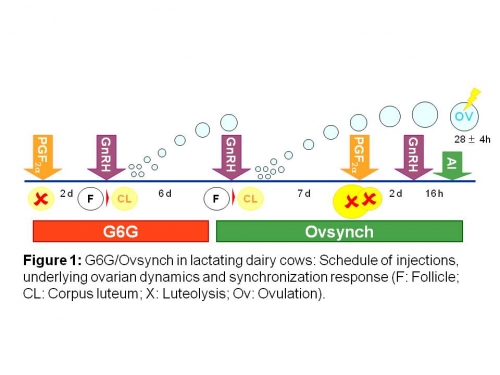J. Richard Pursley, PhD
Education/Degree Information
PhD, Reproductive Physiology, University of Wisconsin 1996
MS, Reproductive Physiology, Kansas State University 1992
BS, Dairy Production, Kansas State University 1974
Research Interests
Dairy Cattle Infertility
Infertility of the lactating dairy cow continues to be a critical problem limiting profitability and sustainability of U.S. dairy farms. Reproductive performance of lactating dairy cows is dependent upon three factors: service rate (or estrus detection rate), fertility of the service sire, and maternal fertility. Service rate can be controlled utilizing Ovsynch technology (Figure 1). Ovsynch allows producers to regulate time to 1st and subsequent artificial inseminations (AI). High fertility sires can be chosen utilizing the USDA-ARS sire conception rate summaries. Yet, maternal fertility, defined as the mother's ability to ovulate a competent oocyte and provide an oviductal and uterine environment capable of fertilization and complete embryonic and fetal development, continues to be the key limiting factor for profitable reproductive performance in lactating dairy cows. Ovsynch technology allows for greater control of service rate, yet conception rates of lactating cows are approximately 30% (new data from our laboratory) compared to 60% in virgin dairy heifers when inseminated following a detected estrus. Increasing conception rates of lactating cows to that of heifers would allow producers to employ the most profitable calving interval strategies for cows with varying production capabilities, and increase profit. However, aspects of maternal fertility that are limiting to conception and embryonic/fetal development, and methods whereby Ovsynch can be modified to enhance maternal fertility while continuing to control service rate, are not well understood.

Compelling new data from our laboratory indicate that increasing concentrations of progesterone (P4) prior to prostaglandin F2a (PG)-induced luteolysis during Ovsynch and accelerating the decrease of P4 following PG-induced luteolysis of Ovsynch significantly enhances fertility of lactating dairy cows. More specifically, our data strongly suggest that initiating Ovsynch on d 6 or 7 of the estrous cycle induces ovulation to the 1st GnRH > 90% of the time and induces an accessory corpus luteum thereby increasing concentrations of P4 prior to PG-induced luteolysis. In doing so, the growth of a new dominant follicle is induced allowing for greater control of ovulation of a young yet mature ovulatory follicle. Our data also surprisingly indicate that a large proportion of cows treated with Ovsynch or variations of Ovsynch have little chance for conception if P4 concentrations do not decline to less than 0.5 ng/ml 2 d, and continue to decline, following PG-induced luteolysis. Approximately 23% of cows treated with Ovsynch fall in this category and despite a possible successful synchronization of ovulation few of these cows become pregnant (5%). Additively, enhancing P4 concentrations prior to PG-induced luteolysis and accelerating PG-induced luteolysis during Ovsynch could improve conception rates 20 percentage points (increasing from ~ 35 to 55 %). Increasing 1stservice conception rates 20 percentage points will increase profit $65,000/y on a 500 cow dairy in Michigan.Our long-term research and extension goals are to improve reproductive efficiency of lactating dairy cows to increase profitability of dairy operations.
Articles
Martins et al 20111 1_Pursley.pdf
Related Work
-
Determining the causes of pregnancy loss in lactating dairy cows
Published on June 12, 2024






 Print
Print Email
Email